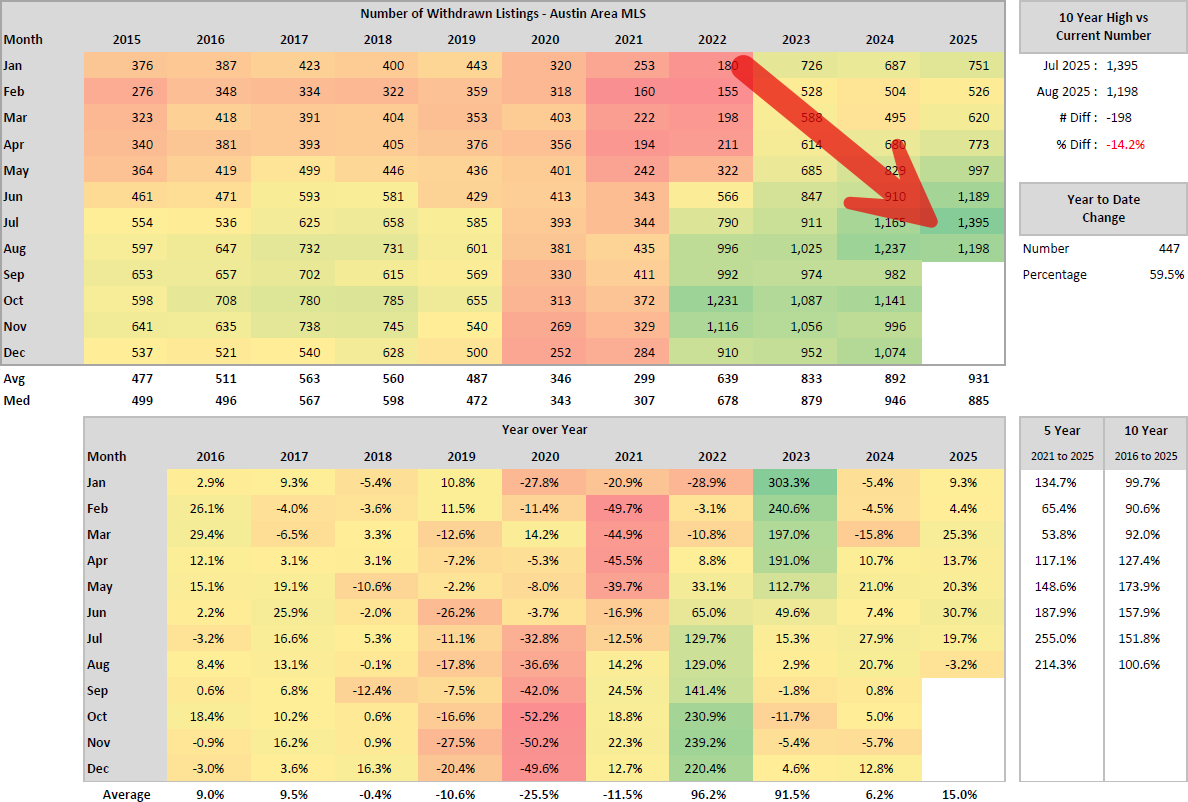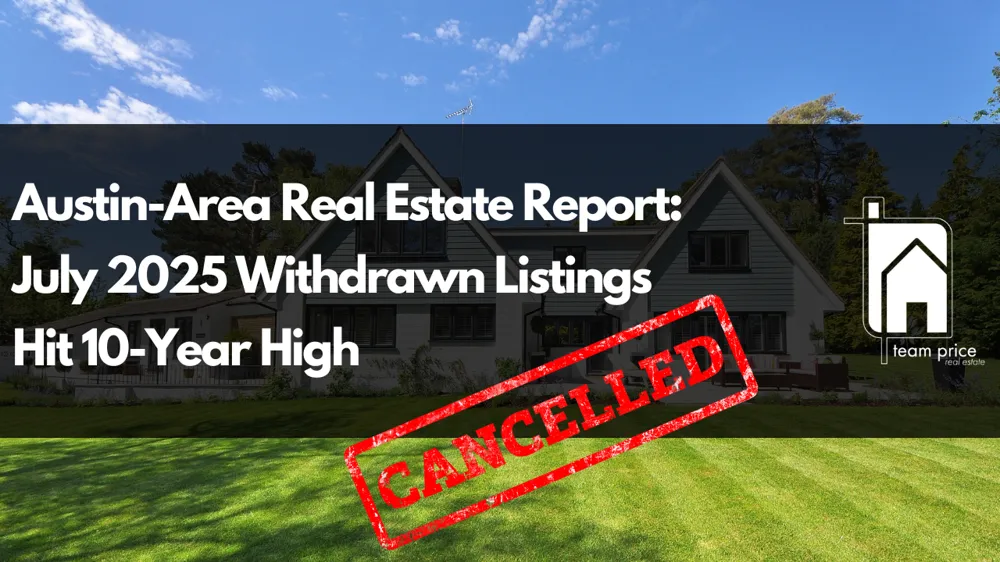Austin-Area Real Estate Report: July 2025 Withdrawn Listings Hit 10-Year High
Published | Posted by Dan Price
July 2025: Austin-Area MLS Withdrawn Listings Hit a 10-Year High
The Austin-Area MLS just recorded a striking new benchmark in the regional housing market: 1,395 residential listings were withdrawn or delisted in July 2025—the highest single-month total in at least a decade. July’s spike isn’t random; it’s a signal about pricing, negotiation leverage, and the mid-year pivot in the Austin-area housing forecast. Compared with July 2024’s 1,165 withdrawn listings, July 2025 climbed 19.7%. Month over month, withdrawals rose 17.3% from June’s 1,189. Relative to pre-pandemic norms, the scale is even more pronounced: July 2019 posted 585 withdrawals, meaning July 2025 ran roughly 138% higher. From the pandemic-era low point in July 2020 (393), the market has swung to a 255% increase. These are not small variations—they represent a substantial shift in seller behavior when offers don’t align with expectations.

In the Austin-Area MLS, “withdrawn” is an off-market status that takes a property out of active marketing before the listing agreement expires. This is distinct from “canceled,” which generally ends the listing agreement, and from “expired,” which reflects the natural end of the listing term. Withdrawn listings remain under contract with the listing broker and can often return to market later without starting over with a new agreement. Once a future obligation date passes, many systems automatically roll a withdrawn listing to expired if no action is taken.
Seasonality plays a role in why July often sees an uptick in withdrawals. Housing activity typically runs strong in spring and early summer, but late July and August often bring a pause before the post-Labor-Day selling window. Some sellers step back to make improvements, re-stage, or adjust pricing strategies for fall. What stands out in 2025 is the scale—July’s withdrawal total isn’t just a seasonal bump, it’s the largest on record for the past decade.
From a supply-and-demand perspective, a high withdrawal month temporarily reduces visible active inventory without generating closed sales. This can create the appearance of a tighter market, but it does not necessarily signal stronger demand. If many of these July withdrawals return to the MLS in September and October with revised pricing and improved presentation, buyers could see a second wave of opportunities. If they remain off-market longer, the available fall inventory could be leaner than it appears, potentially putting some floor under pricing in select segments.
Understanding the operational side of withdrawn status is key for interpreting the Austin-Area real estate forecast. Withdrawn does not mean a home is “off the market forever,” and it doesn’t guarantee a quick return. Some sellers use this status to regroup, while others exit the market entirely. In some MLS rulesets, days-on-market tracking pauses during the withdrawn period; in others, it continues or resumes when the property comes back online. In all cases, compliance with MLS guidelines is critical for timing and re-entry strategy.
The takeaway for late summer is that July’s 10-year high in withdrawals confirms ongoing pricing friction in the Austin-area housing market. Many sellers prefer to withdraw rather than continue price reductions that aren’t delivering results. The fall market will hinge on how this withdrawn inventory is handled. A strategic re-entry with stronger pricing alignment could lead to improved absorption rates. An unchanged re-entry could result in continued longer marketing times and more negotiation pressure from buyers.
August 2025’s withdrawn listings are still in progress and not final, but early counts are tracking below July’s peak. Regardless, July’s record is a defining data point for 2025, shaping both the short-term outlook and the broader Austin-Area housing trends.
FAQ
What does “withdrawn” mean in the Austin-Area MLS, and how is it different from “canceled” or “expired”?
Withdrawn means a listing is taken off the market before the listing agreement expires, usually with the broker’s approval. Canceled ends the listing agreement entirely, and expired occurs when the listing term ends without a sale. Withdrawn listings can return to the market later without starting a new listing agreement.
Why did Austin-Area MLS withdrawals hit a record in July 2025?
The jump to 1,395 withdrawals—up nearly 20% from last year—suggests sellers are pulling back when offers fail to meet expectations. Seasonal factors contribute, as many owners prefer to pause in late summer and re-list in early fall when buyer activity typically picks up.
Does withdrawing a listing reset Days on Market (DOM)?
It depends on MLS rules. In some systems, DOM pauses while the property is withdrawn, resuming when it’s reactivated. In others, it continues regardless of status change. In the Austin-Area MLS, DOM rules should be verified before planning a withdrawal.
When do withdrawn listings usually come back?
Many withdrawn listings reappear after Labor Day with refreshed marketing, updated photos, or adjusted pricing to capture the fall buying season. The timing varies depending on seller goals and market conditions.
Is a high number of withdrawn listings good or bad for the market?
It’s a sign of pricing misalignment, not necessarily of weak demand. If withdrawn listings return with competitive pricing and presentation, they can sell quickly. If they re-enter unchanged, they may linger and require further negotiation.
Related Articles
Keep reading other bits of knowledge from our team.
Request Info
Have a question about this article or want to learn more?


